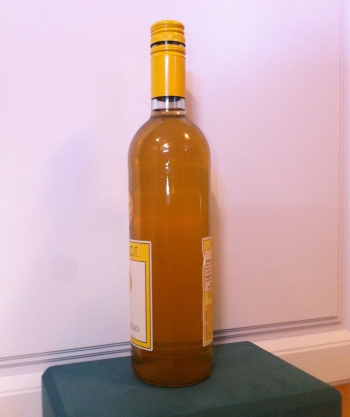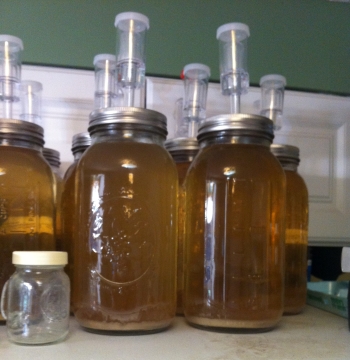
Trish's Small-Scale Meadmaking
Early on, I set aside some honey for mead making. I've also used fermenting honey for mead without compromising flavor. Mead is honey wine - the sugar is from honey instead of grape juice. We have to dilute the honey or it will kill the yeast - 3 parts water to 1 part honey, by weight. To make mead, mix 1 part honey to 3 parts water, add yeast, and wait 9 months to a year. Oh, you'll want to rack once, and you'll want to bottle it. But, it's that simple! See this site for more about mead, its history, and making mead the (really) old fashioned way.
There are many mead making websites, like this one and this one , since mead is the hot new thing! Those website have many more steps than the handful I have listed. Sometimes that means the authors have learned a step is important from the school of hard knocks.


Sometimes they are just repeating "the lore" - what their instructions told them to do, which frankly are sometimes a poor fit because they are based on winemaking. For example, boiling water and/or honey? Never never! Too much of the delightful essences of honey will be destroyed. No boiling necessary. The worst you can end up with when making mead is a very obvious yuck mix of mostly mold but some bacteria. But no secretly toxic bacteria will survive the alcohol and competition from the yeast. See fancier descriptions and pics here.
A very basic "Show Mead" recipe.
A "show mead" is one that is simply honey, water, and yeast. It allows the honey to really shine. This is frowned upon by modern meadmakers, because the hi-acid (honey is pretty acidic actually) and low-nitrogen (and not much protein) environment stresses the yeast, which can add its own flavors. It takes longer too. I have accidentally cheated with this method - I am not measuring out 1/10 of a yeast packet for my 1/2 gallon jug. I use about 1/4 packet in a half-gallon of must. I'm probably at 5 times too much yeast. So there's some protein right there...because more yeast than can be supported by the sugar will die, and then their nutrients go into the still-living yeast. Gross but that's fermenting.
Very Basic Mead Making Recipe, makes 2 bottles of mead in 9 months to a year
Equipment and ingredients to get on hand:
- one half-gallon jar
- a fermenting lid
- one packet of Lalvin D-47 yeast, of which you'll use about 1/4, so keep the rest in the fridge
- 1.5 lbs honey (or two half-pint jelly jars, or 1/2 quart, or 4 cups)
- a half gallon of 90-100 degree F water, in a cooking pot.
Steps to mix ingredients:
- Heat the half gallon of water to 90-100 degress F, then take a cup of that water and mix about
a quarter packet of the yeast. This should sit for 10 min or so to "prove" it will be able to ferment.
- Add the honey to the hot water, stir until dissolved, then add the cup of water with the yeast.
Pour into the half-gallon jar, and put on the fermentation airlock. Done! Sort of.
- In a day or so, the airlock should indicate increased air pressure from carbon dioxide from fermentation.
If not, mix in 1/4 packet of yeast, mixed with liquid, as before. Then...Wait 2 months. Watch the mead clarify.
- Pour (or "rack") the mead into a pot, avoiding the dead yeast at the bottom.
I use an auto-siphon
to transfer the fluid. Then rinse your jar, and put the mead back in. You'll probably need to
add a cup or so of water here to get you within a half inch of the top. This allows the mead
flavor to mature without adding a "dead yeast" flavor. But...I've left the mead with the lees (AKA dead yeast)
for...lots of months... and it tasted fine later. I'm a pretty relaxed mead maker, or maybe making mead is very forgiving.
- Then wait another couple of months. You're trying to get the yeast to finish all the sugar that
was left. You don't want fermentaion in your corked wine bottle!
- Then, at about 5 months after you started, you'll need 1 more piece of equipment: 2 wine bottles,
and corks. No need to go crazy sterilizing re-used wine bottles, but you'll want to rinse those well.
At least, I do. To transfer the mead from the half gallon jar to the bottle,
again the auto siphon comes in handy. I keep my bottles by the sump, just in case I made very dangerously fizzy mead and something blows...
Well, that's actually a lot of steps. It is a year's worth of work!
According to The Compleat Meadmaker,
mead is the most forgiving fermentable beverage you can make. Suits my learning style well!
And one fun option with the half-gallon fermenting vessel: if you start one half-gallon of mead a month,
then in 12 months or so, you'll be ready to start a
meadmaking club with 2 bottles each of 3 finished meads to sample, and more on the way. Small club, or small sample sizes.
And each month, one can change an aspect of the meadmaking - the honey source, the yeast, the nutrient addition, even the water
source, not to mention the timing of nutrient addition... or add flavors like hot peppers - see the next page!
Be aware that mead is as strong as wine, and should be enjoyed as such. So have responsible fun.
Here is a pdf of these instructions.
For advanced meadmaking, and a pdf of recipes, go to the next page.
- Equipment and ingredients to get on hand:
- one half-gallon jar
- a fermenting lid
- one packet of Lalvin D-47 yeast, of which you'll use about 1/4, so keep the rest in the fridge
- 1.5 lbs honey (or two half-pint jelly jars, or 1/2 quart, or 4 cups)
- a half gallon of 90-100 degree F water, in a cooking pot.
- Steps to mix ingredients:
- Heat the half gallon of water to 90-100 degress F, then take a cup of that water and mix about a quarter packet of the yeast. This should sit for 10 min or so to "prove" it will be able to ferment.
- Add the honey to the hot water, stir until dissolved, then add the cup of water with the yeast. Pour into the half-gallon jar, and put on the fermentation airlock. Done! Sort of.
- In a day or so, the airlock should indicate increased air pressure from carbon dioxide from fermentation. If not, mix in 1/4 packet of yeast, mixed with liquid, as before. Then...Wait 2 months. Watch the mead clarify.
- Pour (or "rack") the mead into a pot, avoiding the dead yeast at the bottom. I use an auto-siphon to transfer the fluid. Then rinse your jar, and put the mead back in. You'll probably need to add a cup or so of water here to get you within a half inch of the top. This allows the mead flavor to mature without adding a "dead yeast" flavor. But...I've left the mead with the lees (AKA dead yeast) for...lots of months... and it tasted fine later. I'm a pretty relaxed mead maker, or maybe making mead is very forgiving.
- Then wait another couple of months. You're trying to get the yeast to finish all the sugar that was left. You don't want fermentaion in your corked wine bottle!
- Then, at about 5 months after you started, you'll need 1 more piece of equipment: 2 wine bottles, and corks. No need to go crazy sterilizing re-used wine bottles, but you'll want to rinse those well. At least, I do. To transfer the mead from the half gallon jar to the bottle, again the auto siphon comes in handy. I keep my bottles by the sump, just in case I made very dangerously fizzy mead and something blows...
Well, that's actually a lot of steps. It is a year's worth of work!
According to The Compleat Meadmaker,
mead is the most forgiving fermentable beverage you can make. Suits my learning style well!
And one fun option with the half-gallon fermenting vessel: if you start one half-gallon of mead a month,
then in 12 months or so, you'll be ready to start a
meadmaking club with 2 bottles each of 3 finished meads to sample, and more on the way. Small club, or small sample sizes.
And each month, one can change an aspect of the meadmaking - the honey source, the yeast, the nutrient addition, even the water
source, not to mention the timing of nutrient addition... or add flavors like hot peppers - see the next page!
Be aware that mead is as strong as wine, and should be enjoyed as such. So have responsible fun.
Here is a pdf of these instructions.
For advanced meadmaking, and a pdf of recipes, go to the next page.